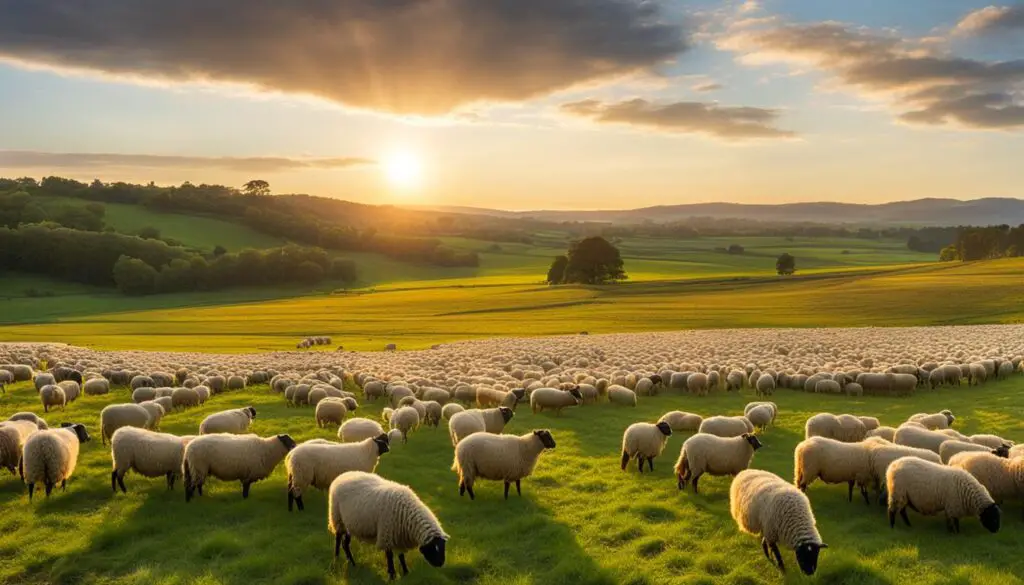Grazing sheep on the right amount of land is essential for their well-being and the success of sheep farming operations. Understanding the optimal sheep acreage, grazing requirements, and grazing area is key to maintaining healthy and sustainable pastures.
One effective approach to grazing sheep is Managed Intensive Rotational Grazing (MIRG). MIRG involves dividing a pasture into small paddocks and rotating the sheep through them for short periods of time. This system stimulates pasture growth, exposes the sheep to a variety of forage, promotes exercise, reduces parasite buildup, and improves soil health.
A University of Minnesota Extension presentation suggests that a stocking density of 33 Animal Units (AU) per acre per day is optimal for MIRG. Each mature sheep requires about 264 square feet of space in the paddock, and the recommended grazing rotation should occur every 3-4 days. Square paddocks of around 60’x60′ are advised for even grazing, and 10 paddocks are needed to achieve a 29-day rest period for the pasture. While the number of sheep per acre can vary depending on pasture productivity, a stocking rate of 33 sheep per acre is a good starting point.
Key Takeaways:
- The Managed Intensive Rotational Grazing (MIRG) system maximizes pasture growth and provides various benefits for sheep grazing.
- A stocking density of 33 Animal Units per acre per day is recommended for MIRG.
- Each mature sheep requires approximately 264 square feet of space in the paddock.
- Grazing rotation should occur every 3-4 days, with square paddocks of around 60’x60′ for even grazing.
- Consulting with agricultural experts or experienced sheep farmers can provide region-specific guidance for optimal sheep acreage.
Understanding the optimal land per sheep ratio and implementing effective grazing practices ensures the well-being and productivity of the sheep while maintaining sustainable pastures. By following these guidelines and seeking expert advice, sheep farmers can create thriving grazing operations for their flocks.
Factors Affecting Sheep Stocking Rate
Calculating sheep land requirements and determining the optimal acre per sheep ratio are essential considerations for successful sheep husbandry. The stocking rate of sheep, or the number of sheep per acre of land, can be influenced by various factors that impact their grazing needs and overall well-being.
One of the important factors to consider is the breed and size of the sheep. Different breeds may have different grazing requirements and dietary preferences. Additionally, larger sheep may require more space than smaller ones to ensure their comfort and adequate movement.
The local climate also plays a significant role in determining the stocking rate. Different climates affect the availability of forage and the nutritional content of the pasture. In regions with abundant rainfall and lush vegetation, the stocking rate may be higher compared to arid or extreme climates.
Soil quality is another factor that influences the stocking rate. The productivity of the soil directly impacts the amount and quality of forage available for the sheep. Rich and fertile soil can support a higher stocking rate, while poor soil may require additional land for grazing or supplementation.
Implementation of a paddock rotation system is crucial for maintaining a sustainable grazing system. Regularly rotating the sheep to different paddocks allows the pasture to rest and regenerate, ensuring ample forage for the animals. This grazing management technique helps maintain optimal pasture health and prevents overgrazing.
Considering these factors and calculating the appropriate stocking rate is vital for effective land allocation in sheep husbandry. It ensures that the sheep have access to sufficient grazing areas, promotes their well-being, and supports sustainable pasture management.
Calculating Sheep Stocking Rate
Calculating the stocking rate for sheep is crucial to ensure the optimal land size for sheep farming. This calculation involves considering the forage needs and body weight of the animals. By estimating the daily foraging amount per sheep, we can determine the acreage needed to sustain a thriving sheep population.
The recommended method is to assume that sheep consume 3% of their body weight in forage each day. To account for waste and provide a buffer, we add an additional 0.5%. Therefore, the total foraging amount per sheep becomes approximately 4% of their body weight.
To calculate the stocking rate, multiply the total acres of land by the average per-acre yield of forage. Then divide this value by the product of 365 days and 4% of the average sheep weight. This equation provides an estimate of the number of sheep that can be sustained on the given land.
However, it’s crucial to consider several other factors in determining the acreage needed for sheep. The quality and availability of forage, climate conditions, and soil quality can all impact the stocking rate. It’s essential to evaluate these factors to create a sustainable and productive sheep farming environment.

| Factors to Consider | Considerations |
|---|---|
| Breed and Size of Sheep | Different breeds have varying grazing needs, and larger sheep may require more space. |
| Local Climate | Climate affects forage availability and nutritional content, determining the stocking rate. |
| Soil Quality | The productivity of the soil impacts the amount and quality of forage for the sheep. |
| Paddock Rotation | Implementing a rotation system ensures sustainable grazing by allowing pastures to rest and regenerate. |
Conclusion
Determining the optimal land per sheep ratio is crucial for successful sheep farming. By implementing Managed Intensive Rotational Grazing (MIRG) and calculating the stocking rate based on forage needs, farmers can ensure the well-being and productivity of their sheep.
Factors such as breed, climate, and soil quality also play a significant role in determining the ideal land per sheep ratio. Consulting with local agricultural extension services or experienced sheep farmers can provide valuable guidance tailored to specific regions and individual circumstances.
In addition to pasture management, providing adequate indoor and outdoor living spaces is essential for the overall health and welfare of the sheep. A well-managed sheep operation considers the sheep’s grazing needs and ensures a healthy and sustainable pasture, optimizing sheep productivity.
By following these guidelines and best practices, sheep farmers can effectively manage their grazing operations, maintain a healthy and productive pasture, and ultimately achieve success in their sheep farming endeavors.
FAQ
What is managed intensive rotational grazing (MIRG)?
Managed intensive rotational grazing (MIRG) is a system of pasturing animals that involves dividing a pasture into small paddocks and rotating the animals through them for short periods of time. This approach maximizes pasture growth and has several benefits for the animals and the soil.
What is the optimal stocking density for MIRG?
The optimal stocking density for MIRG is 33 Animal Units (AU) per acre per day, according to a University of Minnesota Extension presentation.
How much space does each mature sheep require in the paddock?
Each mature sheep requires about 264 square feet of space in the paddock.
How often should the grazing rotation occur?
The grazing rotation should occur every 3-4 days to ensure optimal pasture growth.
How many paddocks are needed for a 29-day rest period?
To achieve a 29-day rest period for the paddocks, 10 paddocks are needed.
What is a recommended paddock size for even grazing?
Square paddocks of around 60’x60′ are recommended for even grazing.
How many sheep can be stocked per acre?
The number of sheep per acre can vary depending on pasture productivity, but a stocking rate of 33 sheep per acre is a good starting point.
What factors influence the optimal number of sheep per acre?
Factors that influence the optimal number of sheep per acre include the breed and size of the sheep, local climate, soil quality, and the implementation of a paddock rotation system.
How do you calculate the stocking rate for sheep?
The recommended method is to estimate the daily foraging amount per sheep based on the assumption that they consume 3% of their body weight in forage each day. By considering the total acres of land, the average per-acre yield of forage, and the average sheep weight, an estimate of the number of sheep that can be sustained on the given land can be calculated.
What are the key considerations for determining the optimal land per sheep ratio?
Key considerations for determining the optimal land per sheep ratio include implementing MIRG, calculating the stocking rate based on forage needs, considering factors like breed, climate, and soil quality, and providing adequate indoor and outdoor living spaces.
Where can I find specific guidance for my region and circumstances?
It is recommended to consult with local agricultural extension services or experienced sheep farmers for specific guidance tailored to your region and individual circumstances.
